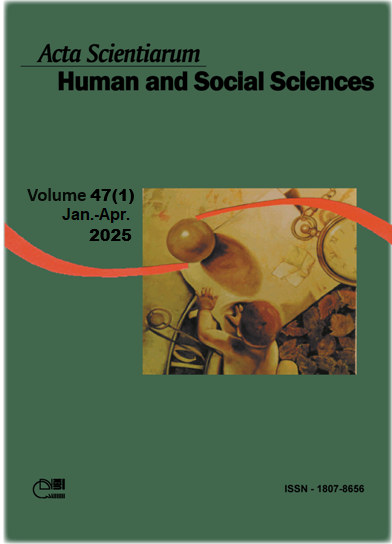Darcy Ribeiro's racial thinking and the ‘dialectic of nobodyhood’
Abstract
The article proposes to examine Darcy Ribeiro's racial thought as an interpreter of brazilianness. In the first place, articulating his confrontation with Gilberto Freyre, through the analysis of Darcy's preface to the Spanish edition of Casa-grande e senzala published by Biblioteca Ayacucho in Venezuela in 1979. It observes the caustic humor of the preface writer faced with Freyre's ‘colonialist anthropology’, emphasizing the methodological and ideological incompatibility between them. Then, it goes back to The brazilian people, Darcy's iconic work, to better explain the dialectical historical materialist perspective that supports the author in the construction of the ‘dialectics of nobodyness’ from the opposite point of view to Freyre, in which miscegenation is not synonymous with harmony. Instead of praising the ‘good coloniser’ and the authoritarian order, Darcy starts with violence as a ‘colonial fact’ that interrupts the course of the ethnic matrixes ‘tupi’, ‘luso’ and ‘afro’ and the complete helplessness of the first brazilian, the ‘brazilindian’ (brasilíndio) who, from the ‘nobodyness’, is dialectically reborn as a ‘new people’, a unique and autonomous civilisation: the utopia. The conclusion is that Darcy's denial of racism or his adherence to the ‘myth of racial democracy’ is implausible although the focus on social inequalities distances it from the TEN's intelligentsia, giving centrality to the ‘black multitude’, to class and social democracy.
Downloads
References
Bicudo, V. L.(2010). Atitudes raciais de pretos e mulatos em São Paulo. Sociologia e Política.
Fernandes, F. (2008a). A integração do negro na sociedade de classes (Vol. 1). Globo.
Fernandes, F. (2008b). A integração do negro na sociedade de classes (Vol. 2). Globo.
Freyre, G. (2013). Casa grande & senzala: formação da família brasileira sob o regime patriarcal. Global.
Gonzalez, L. (1984). Racismo e sexismo na cultura brasileira. Revista Ciências Sociais Hoje, 1(1), 223-244.
Maio, M. C. (1999). O projeto Unesco e a agenda das ciências sociais no Brasil dos anos 40 e 50. Revista Brasileira de Ciências Sociais, 14(41), 141-158. https://doi.org/10.1590/S0102-69091999000300009
Miglievich-Ribeiro, A. M. (2024). Darcy Ribeiro, civilisation and nation: social theory from Latin America. Routledge.
Moura, C. (1988). Sociologia do negro brasileiro. Editora Ática.
Moura, C. (1977). O Negro: de bom escravo a mau cidadão?. Conquista.
Nogueira, O. (1955). Relações raciais no município de Itapetininga. In R. Bastide, & F. Fernandes (Orgs.), Relações raciais entre negros e brancos em São Paulo (pp. 362-554). Unesco-Anhembi.
Rama, Á. (1998). La riesgosa navegación del escritor exiliado. Arca.
Ribeiro, D. (1970). As Américas e a civilização processo de formação e causas do desenvolvimento cultural desigual dos povos americanos. Civilização Brasileira.
Ribeiro, D. (1978). Os brasileiros (Vol. 1, Teoria do Brasil). Vozes.
Ribeiro, D. (1988). O Dilema da América Latina: estruturas de poder e forças insurgentes. Vozes.
Ribeiro, D. (1991). Carta: falas, reflexões, memórias, 1(1).
Ribeiro, D. (1994). Ser negro. Carta: Falas, Reflexões, Memórias, 13(1), 11-18.
Ribeiro, D. (1995), O povo brasileiro. A formação e o sentido do Brasil. Cia das Letras.
Ribeiro, D. (1996). Os índios e a civilização. A integração das populações indígenas no Brasil moderno. Cia. das Letras.
Ribeiro, D. (2001). O processo civilizatório: etapas da evolução sociocultural. Companhia das Letras.
Segato, R. (2006). O Édipo brasileiro: a dupla negação de gênero e raça. Editora da Universidade de Brasília.
Ribeiro, D. (2008). Brasil – Brasis. In I. G. Ferraz (Org.), Darcy Ribeiro. Utopia Brasil (pp.21-36). Hedra.
Vilas Bôas, G. (2004). Casa grande e terra grande, sertões e senzala: duas interpretações do Brasil. Iberoamericana. América Latina-España-Portugal, 4(13), 24-37. https://doi.org/10.18441/ibam.4.2004.13.23-37
Copyright (c) 2025 Adelia Miglievich-Ribeiro

This work is licensed under a Creative Commons Attribution 4.0 International License.
DECLARATION OF ORIGINALITY AND COPYRIGHTS
I Declare that current article is original and has not been submitted for publication, in part or in whole, to any other national or international journal.
The copyrights belong exclusively to the authors. Published content is licensed under Creative Commons Attribution 4.0 (CC BY 4.0) guidelines, which allows sharing (copy and distribution of the material in any medium or format) and adaptation (remix, transform, and build upon the material) for any purpose, even commercially, under the terms of attribution.
Read this link for further information on how to use CC BY 4.0 properly.























